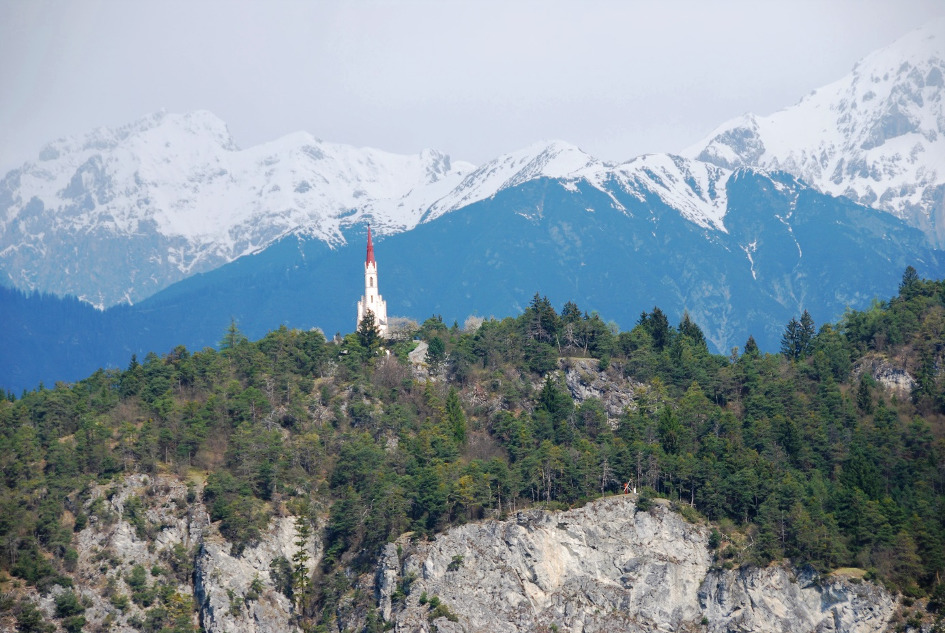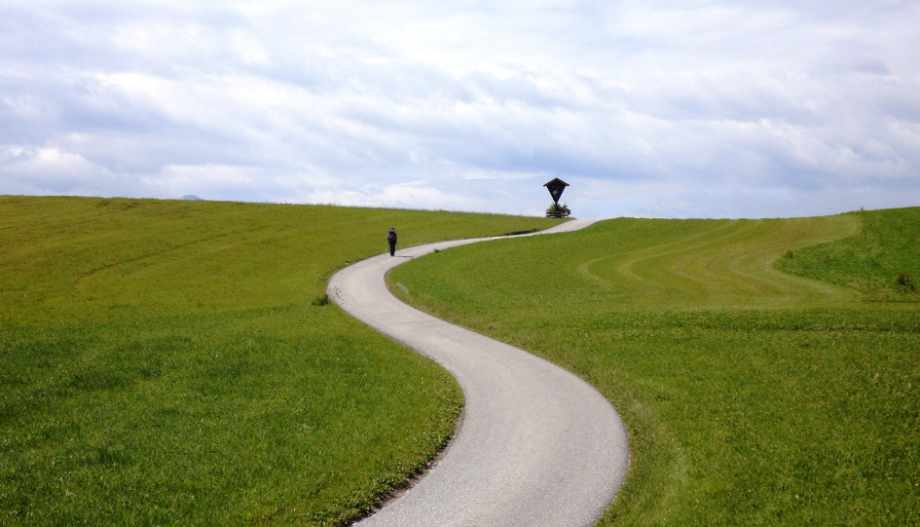PREVIOUS NOTE: The original German text can be read as follows here. The Spanish version has been edited by Alfonso Riobó.
A well-described and well-marked pilgrimage route stretches for almost 800 kilometers across Austria, from its eastern end (Wolfsthal) to the western end (Feldkirch). Like the branching of fine veins, the various tributaries flow into this main branch of the Way of St. James. Among them is the Burgenland Way of St. James, into which a variant of the Hungarian Way of St. James has previously converged. From the north comes the Weinviertel Way of St. James. From Bohemia and Baivera the main branch is reached by the Oberes Mühlviertel Way of St. James. From the south, near Innsbruck, the South Austrian Way of St. James leads to Slovenia, Carinthia, East Tyrol and South Tyrol.

The "pearls" of the road
How do I arrive at the statement that it is a spiritual artery? I am not referring to the effects that a pilgrimage path has on every walker in terms of silence, contemplation and reflection on one's own life, even if one does not (yet) count oneself among the faithful. I am referring rather to the pearls of the road, i.e. to many of the most famous and outstanding shrines in Austria. I mention them only by way of example, for their number is very great.
The first highlight of the Camino is St. Stephen's Cathedral in Vienna, which is also repeatedly referred to as Austria's national shrine. The pilgrim then visits a selection of the most beautiful monasteries in Austria, such as Göttweig and Herzogenburg in Lower Austria, St. Florian and Lambach in Upper Austria, or Fiecht and Stams in Tyrol. These monasteries and other spiritual houses are happy to make their pilgrim rooms available to hikers. Again and again one comes across impressive shrines, of which I name here - again only as an example - Maria Taferl in Lower Austria, Maria Plain in Salzburg or Georgenberg in Tirol.
In addition, many localities strive to offer pilgrims passing through them valuable reflections for the Camino, with the help of boards and images. As an example, I would like to mention the section of the Camino from Gnadenwald to Hall in Tyrol, with several beautiful thoughts and sayings. I will mention one of them here, because it might encourage people to undertake the Camino de Santiago: "Happy are those who hunger and thirst for a meaningful life, for their hunger and thirst will be satisfied. If you always do what you have always done, you will always get what you have always gotten" (Paul Watzlawick). So much for the spiritual aspects, which will not leave any hiker on this Camino de Santiago indifferent.
Stunning landscapes
However, the description of the Austrian Way of St. James would be more than incomplete if I did not also stop to delight in the beauty of the landscapes.
It starts in the Danube meadows near Hainburg, drives through the imperial city of Vienna, through the Viennese forest (the Wienerwald) and up the Danube, through the world cultural heritage of the Wachau, to Linz.
After passing through the charming hilly region of Upper Austria, you reach one of the most beautiful cities in the world, Salzburg. After crossing the Bavarian border region of Rupertiwinkel, the route leads along the impressive Wilder Kaiser mountain range to the Inn Valley. Sometimes to the right, sometimes to the left, the pilgrim and pilgrimess walk upstream above the busy valley floor. Almost every hour they encounter secluded chapels, magnificent churches, castles and palaces, as well as villages and towns worth seeing. The so-called "holy land of Tyrol" lives up to its reputation, because you pass many pilgrimage sites that tell pilgrims their impressive stories. High above the pilgrimage route greet the high Tyrolean mountains.
When the Inn turns towards its source, in the direction of Switzerland, it is time to cross the Arlberg, the only major mountain pass on the Austrian Way of St. James, unless you prefer to switch to public transport for this stage. Finally, the pilgrimage route crosses the beautiful foothills of the Vorarlberg Alps before crossing the border at Feldkirch in the direction of Liechtenstein or Switzerland.

I have walked the Austrian Way of St. James from east to west on several occasions. I went on pilgrimage through Lower Austria in the heat of early summer. I passed through the Inn Valley twice, the first time in March, walking from Salzburg to Santiago de Compostela for a total of three months. At that time, the Arlberg was still covered in deep snow and threatened by avalanches. However, with the help of cross-country skis, which I had deposited there on another occasion, I was able to overcome this pass with ease. The second time I hiked in the Tyrol in May, I was amazed by the splendor of the colors and the beauty of the landscape. While the spruce fields in the mountains were still shining in the sun, in the valley flowers and shrubs were blooming in their lush splendor.
From my first Camino de Santiago - just after my retirement - however, I also know the Via Jacobi in Switzerland, the Via Gebennensis and the Via Podiensis in France, the Camino Norte and the Primitivo in Spain. About two years ago, I also knew the French Way in Spain. I have collected in books my experiences and impressions of my Camino de Santiago. Comparing the different routes of the Camino de Santiago, I can say that the Austrian Camino de Santiago, in terms of attractiveness and beauty, does not lag at all behind its even more famous siblings.
A longing in the heart
Anyone who has walked the Camino de Santiago has seen so much scenic beauty and experienced so much spiritual depth - even taking into account the hardships and privations he or she may have experienced - that the longing to set out again remains in the heart. This longing is awakened, above all, when one finds a signpost or a sign of the Camino de Santiago in one's immediate surroundings, as happens, in my case, in Salzburg. Then one realizes that there is a well-marked road that starts from that place and leads for thousands of kilometers directly to the tomb of St. James of Compostela. Ultreia!








